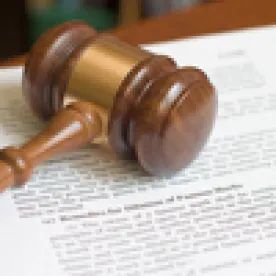The Second Circuit disagrees with sister circuits and rejects arguments that nominative fair use is an affirmative defense that is available even when confusion is likely and that the traditional nominative fair use analysis supplants the Polaroid test for likelihood of confusion.
In its May 18 decision in International Information Systems Security Certification Consortium, Inc. v. Security University, LLC[1] (IISSCC), the US Court of Appeals for the Second Circuit held that nominative fair use is not an affirmative defense to infringement that can be asserted even if a plaintiff has established a likelihood of confusion. The court also provided valuable guidance on how nominative fair use should be analyzed in this important trademark jurisdiction.
Background
Plaintiff-appellant International Information Systems Security Certification Consortium, Inc. (ISC2) filed suit against defendants‐appellees Security University (SU) and Sondra Schneider, alleging that SU’s use of ISC2’s certification mark violated the Lanham Act, among other claims.
ISC2 developed a certification program and began using the certification mark CISSP® to denote a Certified Information Systems Security Professional who has met certain requirements and standards of competency in the information security field, including passing the CISSP® certification examination administered by ISC2. Although SU instructors could accurately identify themselves as being CISSP®-certified, ISC2 argued that SU advertisements misleadingly suggested that one of SU’s instructors, Clement Dupuis, had attained some higher level of certification as a Master CISSP or CISSP Master. For example, one advertisement read, “Register for CISSP® Prep class with Master CISSP Clement Dupuis today!”
The US District Court for the District of Connecticut granted the defendants’ motion for summary judgment on the infringement claims based in part on the ground that defendants’ use of the certification mark was permissible under the doctrine of nominative fair use. Nominative fair use is a “use of another’s trademark to identify, not the defendant’s goods or services, but the plaintiff’s goods or services.”[2] It is called “nominative” use “because it ‘names’ the real owner of the mark.”[3]
In conducting its analysis, the district court applied the US Court of Appeals for the Ninth Circuit’s nominative fair use test, according to which “[n]ominative fair use applies when all three of the following requirements are met: ‘[1]the product or service in question must be one not readily identifiable without use of the trademark; [2]only so much of the mark or marks may be used as is reasonably necessary to identify the product or service; and [3]the user must do nothing that would, in conjunction with the mark, suggest sponsorship or endorsement by the trademark holder.’”[4] Finding that the defendant had succeeded on all three elements, the district court granted summary judgment in favor of the defendants. ISC2 appealed.
The Second Circuit’s Decision in IISSCC
The Second Circuit reversed the summary judgment in favor of the defendants based on their nominative fair use defense. As an initial matter, the Second Circuit reiterated that its test for assessing likelihood of confusion in all trademark infringement cases, including cases involving nominative fair use, is the familiar Polaroid test. The Polaroid test requires courts to consider the following eight nonexclusive factors:
-
Strength of the trademark
-
Similarity of the marks
-
Proximity of the products and their competitiveness with one another
-
Evidence that the senior user may “bridge the gap” by developing a product for sale in the market of the alleged infringer’s product
-
Evidence of actual consumer confusion
-
Evidence that the imitative mark was adopted in bad faith
-
Respective quality of the products
-
Sophistication of consumers in the relevant market[5]
The Second Circuit urged district courts “to apply the Polaroid factors even where a factor is irrelevant to the facts at hand.”[6] As the Second Circuit previously explained, “it is incumbent upon the district judge to engage in a deliberate review of each factor, and, if a factor is inapplicable to a case, to explain why.”[7]
The Second Circuit acknowledged that some of the Polaroid factors—or their analogues in other circuits—are not easily applied in cases of nominative fair use. As a result, various courts, including the US Courts of Appeals for the Ninth and Third Circuits, had developed different approaches to the nominative fair use doctrine.
The Second Circuit first considered the nominative fair use test adopted by the Ninth Circuit in New Kids on the Block v. News America Publishing, Inc, which, as discussed above, applies when (1) the product or service in question is not readily identifiable without use of the trademark, (2) only so much of the mark is used as is reasonably necessary to identify the product or service, and (3) the user does nothing that would, in conjunction with the mark, suggest sponsorship or endorsement by the trademark holder.[8]
This test replaces the Ninth Circuit’s analogue to the Polaroid multifactor likelihood of confusion test in cases involving nominative fair use. According to the Second Circuit, the nominative fair use defense in the Ninth Circuit is not an affirmative defense because it does not protect a defendant from liability if there is a likelihood of confusion.
According to the Second Circuit, the Third Circuit’s nominative fair use doctrine affords defendants broader protection than the Ninth Circuit’s test. Citing Century 21 Real Estate Corp. v. Lendingtree,[9] the Second Circuit concluded that nominative fair use was an affirmative defense in the Third Circuit that could be asserted by the defendant even if there is a likelihood of confusion. The Third Circuit concluded that nominative fair use was properly considered an affirmative defense because the US Supreme Court previously held that classic, or descriptive, fair use was an affirmative defense.[10] To prevail on a nominative fair use defense in the Third Circuit, a defendant must show the following:
-
That the use of plaintiff’s mark is necessary to describe both the plaintiff’s product or service and the defendant’s product or service
-
That the defendant uses only so much of the plaintiff’s mark as is necessary to describe plaintiff’s product
-
That the defendant’s conduct or language reflects the true and accurate relationship between plaintiff and defendant’s products or services[11]
After analyzing the language of the Lanham Act, the case law, and the position of the US Patent and Trademark Office as set forth in letter briefs filed with the Second Circuit, the Second Circuit did not adopt the approach taken by either the Ninth or the Third Circuit. The Second Circuit rejected the Third Circuit’s treatment of nominative fair use as an affirmative defense. The Second Circuit primarily relied on the fact that nominative fair use is not enumerated in 15 U.S.C. § 1115(b) as an affirmative defense to infringement claims that can be asserted even if the plaintiff has established a likelihood of confusion, in contrast to classic, or descriptive, fair use. As a result, the Second Circuit concluded that the nominative fair use defense was not available if the use is likely to cause consumer confusion.
On the other hand, the Second Circuit also rejected the Ninth Circuit’s approach of supplanting the likelihood of confusion analysis set forth in Polaroid and analogous cases with a distinct nominative fair use analysis. However, because the Second Circuit concluded that the factors considered by the nominative fair use test would be helpful to a district court’s analysis, it held that, in nominative fair use cases, district courts should consider the Ninth Circuit and Third Circuit’s nominative fair use factors in addition to the Polaroid factors. Thus, when considering a likelihood of confusion in nominative fair use cases,
in addition to discussing each of the Polaroid factors, courts are to consider: (1) whether the use of the plaintiff’s mark is necessary to describe both the plaintiff’s product or service and the defendant’s product or service, that is, whether the product or service is not readily identifiable without use of the mark; (2) whether the defendant uses only so much of the plaintiff’s mark as is necessary to identify the product or service; and (3) whether the defendant did anything that would, in conjunction with the mark, suggest sponsorship or endorsement by the plaintiff holder, that is, whether the defendant’s conduct or language reflects the true or accurate relationship between plaintiff’s and defendant’s products or services.[12]
In sum, although the Second Circuit agreed with the Ninth Circuit that nominative fair use is not an affirmative defense that is available even when confusion is likely, it disagreed with the Ninth Circuit’s adoption of a separate nominative fair use test to replace the traditional multifactor likelihood of confusion analysis.
Practical Implications
Although the nominative fair use defense to trademark infringement has been recognized by at least some courts for decades, the nature and scope of the defense remains uncertain and varies by jurisdiction. Unless and until a forum and governing law for a given dispute has been firmly established, parties that intend to rely on nominative fair use of trademarks should not presume that they can necessarily avoid liability merely because they are using a competitor’s mark to accurately describe its competitor’s product or service and they are not using more of their competitor’s mark than is necessary to identify the competitive product or service. In at least in two key circuits for trademark litigation, a party may be liable for trademark infringement even if it meets these other requirements, provided there is a likelihood of confusion.
In addition, now that there is a clear circuit split on whether nominative fair use is an affirmative defense that is available even if confusion is likely and how to properly analyze the likelihood of confusion in nominative fair use cases, this is an issue that may be ripe for resolution by the US Supreme Court, especially in light of its recent interest in intellectual property cases generally and the Lanham Act, in particular.
[1] 14-3456-cv (2d Cir. May 18, 2016) (hereinafter “Op.”).
[2] 4 McCarthy on Trademarks and Unfair Competition § 23:11 (4th ed.).
[3] Id.
[4] IISSCC, 2014 WL 3891287, at *4 (quoting New Kids on the Block v. News Am. Publ’g Inc., 971 17 F.2d 302, 308 (9th Cir. 1992)).
[5] Polaroid Corp. v. Polarad Electronics Corp., 287 F.2d 492, 495 (2d Cir. 1961).
[6] Op. at 31 (quoting Arrow Fastener Co. v. Stanley Works, 59 F.3d 384, 400 (2d Cir. 1995)).
[7] Id.
[8] 971 F.2d 302, 308 (9th Cir. 1992) (footnote omitted).
[9] 425 F.3d 211, 222 (3d Cir. 2005).
[10] See Century 21 Real Estate Corp., 425 F.3d at 222 (citing KP Permanent Make‐Up, Inc. v. Lasting Impression I, Inc., 543 U.S. 111, 118‐20 (2004)).
[11] Op. at 34 (quoting Century 21 Real Estate Corp., 425 F.3d at 222)
[12] Op. at 38-39 (emphasis in original).




 />i
/>i

